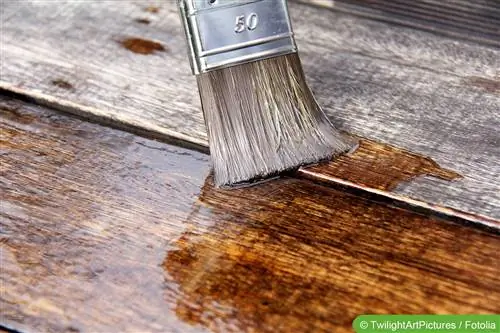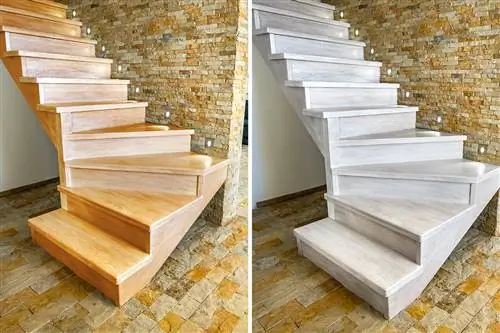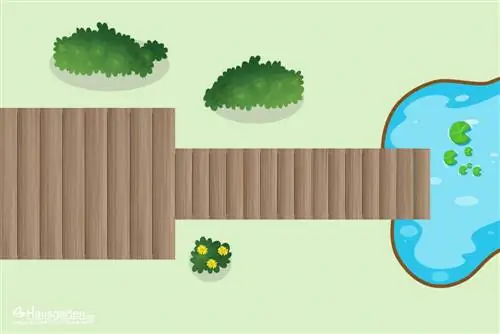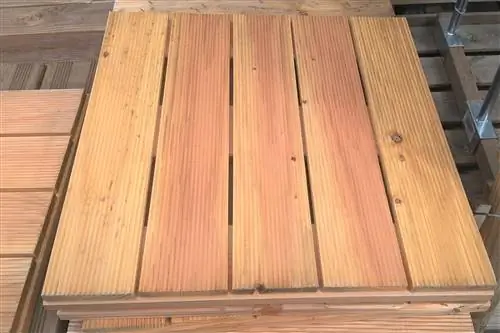- Author admin [email protected].
- Public 2023-12-17 03:39.
- Last modified 2025-01-24 12:45.
If you want to enjoy your wooden terrace for a long time, choosing the right wood and caring for it is essential. Especially outdoors, the wooden terrace is constantly exposed to wind and weather for many years, so some types of wood need help to stay beautiful.
Wood care is not just about protecting wood from the elements. Many people also use care products because they want to emphasize the grain of the wood or want to avoid the appearance of patina.
Which wood for the terrace?
The first step is to choose the right wood. The choice is large and can be confusing. Both local and tropical woods are used in terrace construction. While tropical woods such as Ipe, Bangkirai and Massaranduba have so far been in the lead, thanks to special processes, more and more local woods are entering the market.
The local wood is only partially suitable for building terraces without treatment. There are only a few types of wood that naturally have the properties to be used outdoors for decades without protection. However, by regularly treating it with glaze, it is definitely possible to enjoy such wood for a long time.
Which types of wood need to be glazed?
A glaze is not common for tropical woods. They are mainly cared for with natural-based oils or waxes. The main reason for this is that it's all about the look.
Oil or wax preserves the natural grain of the wood.intensified, the wood remains supple and shiny. These care products also have a somewhat protective function against the weather, but the naturally extremely durable tropical woods do not necessarily require this.
Douglas fir is a native type of wood that is often used for building terraces. However, it does not have ideal properties. It has a shelf life of 10 to 15 years, is susceptible to rot and fungi without treatment and in direct contact with the ground, but with a suitable glaze, Douglas fir has still proven itself as a terrace wood.
Stain is often used on Douglas fir, on the one hand to achieve the protective function and on the other hand to give the wood a darker color. If you like the natural color of Douglas fir, choose a colorless glaze.
If you want to change something, there is a large selection of glazes available. Like Douglas fir, larch and robinia are suitable for treatment with glaze.
What criteria does the glaze have to meet?
It is important that the glaze is environmentally friendly. Last but not least, this not only benefits the environment itself, but also people and animals who use the terrace every day. Since you often do this barefoot, you should attach importance to the glaze being well tolerated. Wood is also a living material.
It breathes and, even after processing, contributes to climate protection by binding carbon dioxide. But it can only do this if the pores of the wood are open. That's why you should choose a glaze that is based on linseed oil and to which color pigments may have been added.
If the wooden terrace has been glazed, the glaze must be renewed regularly. This is necessary approximately every one to two years. Before you use a glaze, you have to find out whether the wood needs to or can be glazed. Many types of wood are better cared for with oils or waxes, but if it is absolutely necessary to use glaze, it is important to know that the wood can tolerate treatment with glaze.
Frequently asked questions
Which wood and glaze to use for a wooden terrace?
If you want to enjoy your wooden terrace for a long time, choosing the right wood and caring for it is essential. Especially outdoors, the wooden terrace is constantly exposed to wind and weather for many years, so some types of wood need help to stay beautiful.
Wood care is not just about protecting wood from the elements. Many people also use care products because they want to emphasize the grain of the wood or want to avoid the appearance of patina.
Which wood for the terrace?
The first step is to choose the right wood. The choice is large and can be confusing. Both local and tropical woods are used in terrace construction. While tropical woods such as Ipe, Bangkirai and Massaranduba have so far been in the lead, thanks to special processes, more and more local woods are entering the market.
The local wood is only partially suitable for building terraces without treatment. There are only a few types of wood that naturally have the properties to be used outdoors for decades without protection. However, by regularly treating it with glaze, it is definitely possible to enjoy such wood for a long time.
Which types of wood need to be glazed?
A glaze is not common for tropical woods. They are mainly cared for with natural-based oils or waxes. The main reason for this is that it's all about the look.
Using oil or wax, the natural grain of the wood is preserved or intensified, the wood remains supple and shiny. These care products also have a somewhat protective function against the weather, but the naturally extremely durable tropical woods do not necessarily require this.
Douglas fir is a native type of wood that is often used for building terraces. However, it does not have ideal properties. It has a shelf life of 10 to 15 years, is susceptible to rot and fungi without treatment and in direct contact with the ground, but with a suitable glaze, Douglas fir has still proven itself as a terrace wood.
Stain is often used on Douglas fir, on the one hand to achieve the protective function and on the other hand to give the wood a darker color. If you like the natural color of Douglas fir, choose a colorless glaze.
If you want to change something, there is a large selection of glazes available. Like Douglas fir, larch and robinia are suitable for treatment with glaze.
What criteria does the glaze have to meet?
It is important that the glaze is environmentally friendly. Last but not least, this not only benefits the environment itself, but also people and animals who use the terrace every day. Since you often do this barefoot, you should attach importance to the glaze being well tolerated. Wood is also a living material.
It breathes and, even after processing, contributes to climate protection by binding carbon dioxide. But it can only do this if the pores of the wood are open. That's why you should choose a glaze that is based on linseed oil and to which color pigments may have been added.
If the wooden terrace has been glazed, the glaze must be renewed regularly. This is necessary approximately every one to two years. Before you use a glaze, you have to find out whether the wood needs to or can be glazed. Many types of wood are better cared for with oils or waxes, but if it is absolutely necessary to use glaze, it is important to know that the wood can tolerate treatment with glaze.






